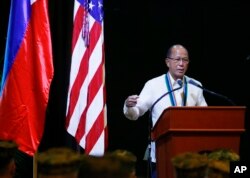Philippine President Rodrigo Duterte on Tuesday declared the country's restive south under martial rule for 60 days after security forces' attempt to capture a top Islamic State-linked militant leader failed, setting off clashes that left a major southern city under siege.
The Philippine military on Tuesday raided a house in Marawi city where IS leader Isnilon Hapilon was thought to be recuperating from wounds suffered in a previous clash. Hapilon is the country's most-wanted man, with a $5 million bounty placed on his head by the U.S. for alleged terrorist acts against American citizens.
"This afternoon at 2 p.m., we launched a surgical operation against Isnilon Hapilon," Lieutenant Colonel Joar Herrera, spokesman for the army division involved in the fighting, told VOA.
Fires, gunshots
Hapilon reportedly called for help from allied fighters. About 20 of them took up positions around a hospital, while others went to attack a jail several miles away. Clashes broke out in the city of 200,000, and residents were hunkered down, with a number of houses reported to be on fire as sporadic gunfire continued into the night.
"There are more or less 50 militants that are fighting," Herrera said. "Right now the Armed Forces of the Philippines are securing all vital installations. They are protecting the city center and coordinating with the community for the safety of the people."
But Philippine Defense Secretary Major General Delfin Lorenzana, who cut short a trip to Russia, told reporters in Moscow that power had been cut off in the city, and that dozens of gunmen had occupied city hall and burned a Catholic church and a college.
"The whole of Marawi city is blacked out. There is no light, and there are Maute snipers all around," Lorenzana said. Maute, one of the largest groups that operate in Lanao del Sur province, reportedly came to Hapilon's aid.
At least two soldiers and a police officer have been killed and 12 others wounded, the defense secretary said.
IS endorsement
IS has endorsed Hapilon as the leader of a loosely affiliated association of small groups that have sprouted in the last three to four years around the central and southern Philippines.
Hapilon swore allegiance to IS leader Abu Bakr al-Baghdadi in a July 2014 video, according to the U.S. State Department. His time as a leader of the brutal Abu Sayyaf group included the 2001 kidnapping of three Americans in the western Philippines, two of whom were later killed.
There are concerns that the new groups may increasingly include Southeast Asian militants who went to fight with IS in Syria and Iraq. Now they are returning to the region, seeking a safe haven where they can regroup, train and plot attacks, authorities in the Philippines told VOA.
Some already have been linked to kidnappings, bombings and attacks on security forces, and troops have found IS uniforms and insignias on slain rebels.
Herrera said security agencies are monitoring foreign fighters' movements to disrupt their plans.
Hotbed of activity
The southern Philippines, particularly the resource-rich but poverty-racked Mindanao region, has long been a hotbed of activity by the Abu Sayyaf and other fundamentalist groups.
With the help of U.S. counterterror trainers and gear, the poorly funded Philippine military has made major inroads against the Abu Sayyaf, but the emergence of the IS-linked groups over the last three or four years raises concerns about the ability to fight on multiple fronts, including a long-running insurgency by the communist New People's Army.
The Abu Sayyaf group — a splinter of the Moro Islamic Liberation Front — was founded in 1991 with funding from al-Qaida. The group is estimated to have 400 members. The United States and the Philippines have blacklisted the Abu Sayyaf as a terrorist organization because of bombings, kidnappings for ransom and beheadings.
The group has been blamed for several attacks in the country, including the 2004 bombing of a ferry in Manila Bay that killed more than 100 people.









